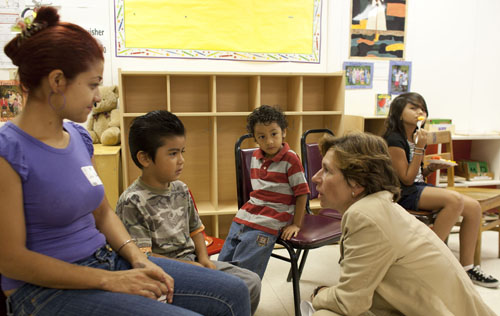
The teaching profession stands at a crossroads. The United States has an opportunity to reform the entire profession and make teaching not only one of America’s most important professions but also one of America’s most respected professions. But first we need to borrow some great ideas from successful educational systems around the world that have already achieved this.
Inspired by Michael Fullan’s and Andrew Hargreaves’ Nuevo libro, Capital Profesional, “La Búsqueda Global para la Educación: En Búsqueda de Profesionales – Parte 1” began to look at what the next generation of American teachers could look like. Today we continue that conversation with someone who understands better than anyone why professional excellence is one of the most vital investments we can make in our children’s future. That person is Randi Weingarten, Presidente de la Federación Americana de Maestros.
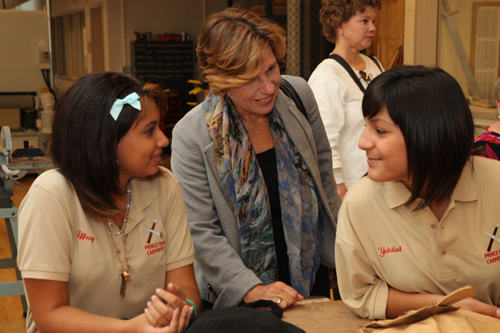
What are the steps we need to take in order to adopt the Hargreaves and Fullan “teach like a pro” action plan?
We have to think about all the issues as collective work not individual work. That is a very different mentality for the United States.
We have to respect teachers. When someone is not doing a good job there is a way to respect him or her but also let him or her know something needs to be done about the problem.
The bigger problem in the United States is the daunting conditions that many teachers work in. Half of our teachers leave in the first 3 a 5 years on the job. Hargreaves and Fullan observe that to get the return on our investment even now you must have teachers stay in the job for at least 8 años. That’s an enormous waste of resources and brainpower that goes out the door. Combating the teacher attrition number is probably the most important issue to address. We must also address what we can do about training teachers before they come into the profession. That must be followed up with more development and support when teachers are on the job. We need a different mentality, es decir. teachers are not simply born, teachers need to be nurtured. We say education of our youth is the most important thing that we do in terms of the future. We cannot in the same breath say it’s okay to just pop somebody in a classroom and say, “Go do it. We will assess you at the end of the year based on the test scores of your kids.”
What is your view of standardized testing in the US with regard to students and to teachers?
I think we are too fixated on standardized tests. Testing has its role. It’s important as a metric stick to help kids understand what they know and are able to do. It is important for teachers and others because it informs on instruction. It can be used as a tool to illustrate where there are strengths and where there are weaknesses. What’s happened in the United States, unlike almost any other country in the world, is that we are out of alignment, meaning that the tests have more consequences for teachers than they do for students. We need to rebalance it. Part of the problem is that testing goes back to the fundamental deprofessionalization of our profession. There will always be the search for the quick fix, the silver bullet, the sense that you can have one intervention that totally changes education for the positive. That does not happen. The quick fix used to be a teacher proof curriculum. Now the quick fix is if we just use test scores as the be all and end all for everything, we’ll know whether or not we are on the right track. Countries that outperform us understand that teachers are physicians of the mind. We should be working on creating a climate that is conducive to teaching and learning.
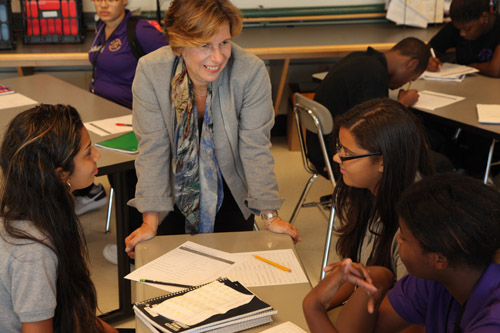
What changes in the teaching profession need to be made in order to address the achievement gap with the 20% of children in the US that are from poor families?
The achievement gap between rich and poor is greater than the achievement gap between black and white. Hay un 40% achievement gap between rich and poor. What we are seeing more and more is that the socio-economic obstacles are very daunting and yet we have an absolute obligation to try to address them. We cannot ignore them. There are several things that have to happen:
Training Training Training.
Support Support Support — once teachers-in-training become teachers.
The countries that outperform us understand that people really have to be prepared to teach in the current environment versus the way teachers were prepared to teach 20 o 30 hace años que.
We need to be very prepared to teach 21st century skills, which is not about simply knowing things. It’s also about knowing how to apply knowledge, how to critically think, how to problem solve and how to work with others. Those things are as important. Some of that is training. Some of that is working together and some of that is discovered on the job itself.
What can we do now about getting star teachers into poor schools?
I think you can do several things and I speak from my own personal experience when I was teaching in the Chancellor’s district in New York City. We had a multi-faceted strategy to turn around poor performing schools into performing schools. We did many things at the same time.
We really focused on the capability of the teaching force. We only accepted certified teachers and we made sure they were supported. We built in extra time to train teachers on an ongoing basis and created a curriculum that everybody bought into and trained on. For these particular schools, the curriculum we used in both literacy and math was used schoolwide. Professional development was aligned with curriculum. We also built in additional time for kids so that if they were falling behind, they got immediate tutoring in the areas in which this was happening. We had more parental outreach. Teachers had a choice to stay in these particular schools, and in exchange for their additional time, for making the choice to stay, and for using the approved curriculum, they got paid an additional 15%. We didn’t have a problem with attrition and we saw in a couple of years that all students in the elementary school had been turned around. We created schools where parents wanted to send their kids and teachers wanted to teach. We had leadership that was collaborative and supportive. We had the tools and conditions to get the job done. If you have all these things, whatever the neighborhood and whatever the environment, experienced teachers will stay.
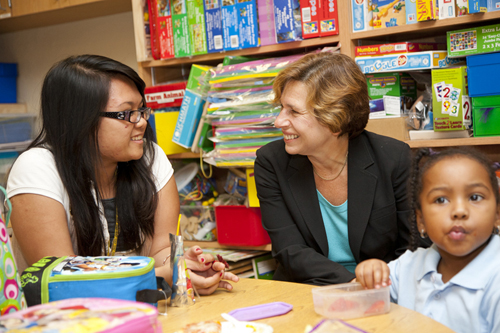
As we move forward into the 21st century, technology continues to play a larger role in teachers’ y estudiantes’ vidas. What are the positive and negatives of technology with regard to improving student learning and assisting teacher training?
One of the biggest challenges teachers face is personalizing and differentiating instruction to meet the needs of all the students in their classrooms. Digital resources and technological tools have tremendous promise to assist in that. Más, technology offers ways to provide extra supports for struggling students, for extending learning beyond textbooks, and for providing access to engaging content. It can be tremendously empowering of both teachers and students. But we have to remember that really integrating technology into the curriculum requires more, not less of teachers. So we really have to make sure that they have the time, desarrollo profesional, equipment, and technical support they need to take advantage of that potential for their students. And we can’t forget that while the digital divide is narrowing, it’s still very real. Reliable internet access and bandwidth are still very real issues in too many of our urban and rural communities. Así, whether you are talking about student learning or teacher training, it’s not the tool — the technology — it’s how you use it. And it matters whether you have the conditions and support to use it well.
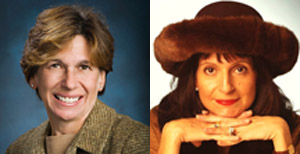

En La Búsqueda Global para la Educación, unirse a mí y reconocidos a nivel mundial los líderes de opinión, incluyendo a Sir Michael Barber (Reino Unido), DR. Michael Bloquear (Estados Unidos), DR. Leon Botstein (Estados Unidos), DR. Linda Darling-Hammond (Estados Unidos), DR. Madhav Chavan (India), El profesor Michael Fullan (Canada), El profesor Howard Gardner (Estados Unidos), Profesor Yvonne Hellman (Países Bajos), Profesor Kristin Helstad (Noruega), Jean Hendrickson (Estados Unidos), Profesor Rose Hipkins (Nueva Zelanda), Profesor Cornelia Hoogland (Canada), Señora. Chantal Kaufmann (Bélgica), DR. Eija Kauppinen (Finlandia), Secretario de Estado Tapio Kosunen (Finlandia), Profesor Dominique Lafontaine (Bélgica), El profesor Hugh Lauder (Reino Unido), Profesor Ben Levin (Canada), Profesor Barry McGaw (Australia), Shiv Nadar (India), Profesor R. Natarajan (India), DR. Denise Papa (Estados Unidos), Sridhar Rajagopalan (India), DR. Diane Ravitch (Estados Unidos), Sir Ken Robinson (Reino Unido), Profesor Pasi Sahlberg (Finlandia), Andreas Schleicher (PISA, OCDE), DR. Anthony Seldon (Reino Unido), DR. David Shaffer (Estados Unidos), DR. Kirsten Immersive Are (Noruega), Canciller Stephen Spahn (Estados Unidos), Yves Theze (Lycee Francais EE.UU.), Profesor Charles Ungerleider (Canada), Profesor Tony Wagner (Estados Unidos), Sir David Watson (Reino Unido), Profesor Dylan Wiliam (Reino Unido), DR. Marcos Wormald (Reino Unido), Profesor Theo Wubbels (Países Bajos), El profesor Michael Young (Reino Unido), y el profesor Zhang Minxuan (De China) a medida que exploran las cuestiones de educación cuadro grande que todas las naciones se enfrentan hoy. La Búsqueda Global para la Educación Comunitaria Página
C. M. Rubin es el autor de dos ampliamente leído serie en línea por la que recibió un 2011 Premio Upton Sinclair, “La Búsqueda Global para la Educación” y “¿Cómo vamos a Leer?” Ella es también el autor de tres libros más vendidos, Incluido The Real Alice in Wonderland.

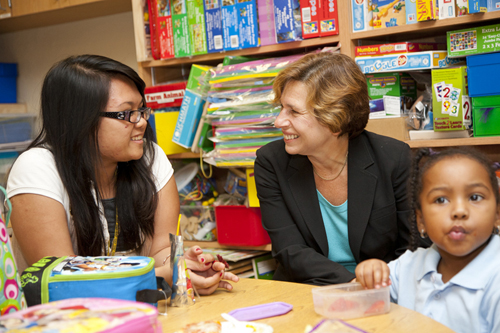
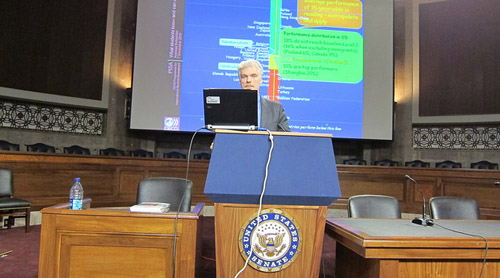
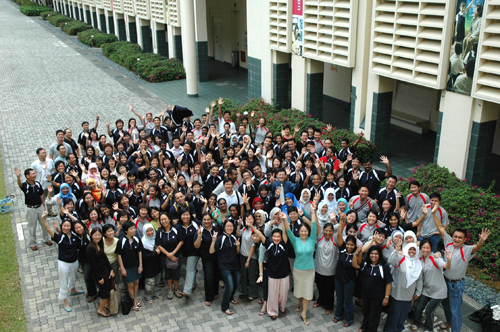
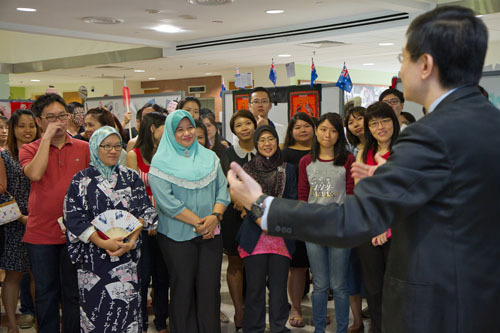
Comentarios recientes